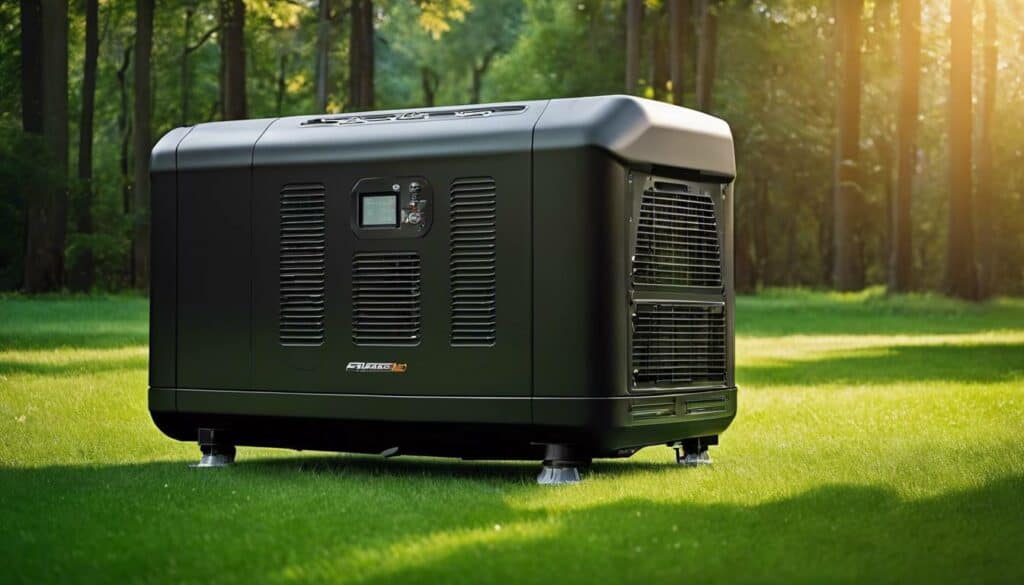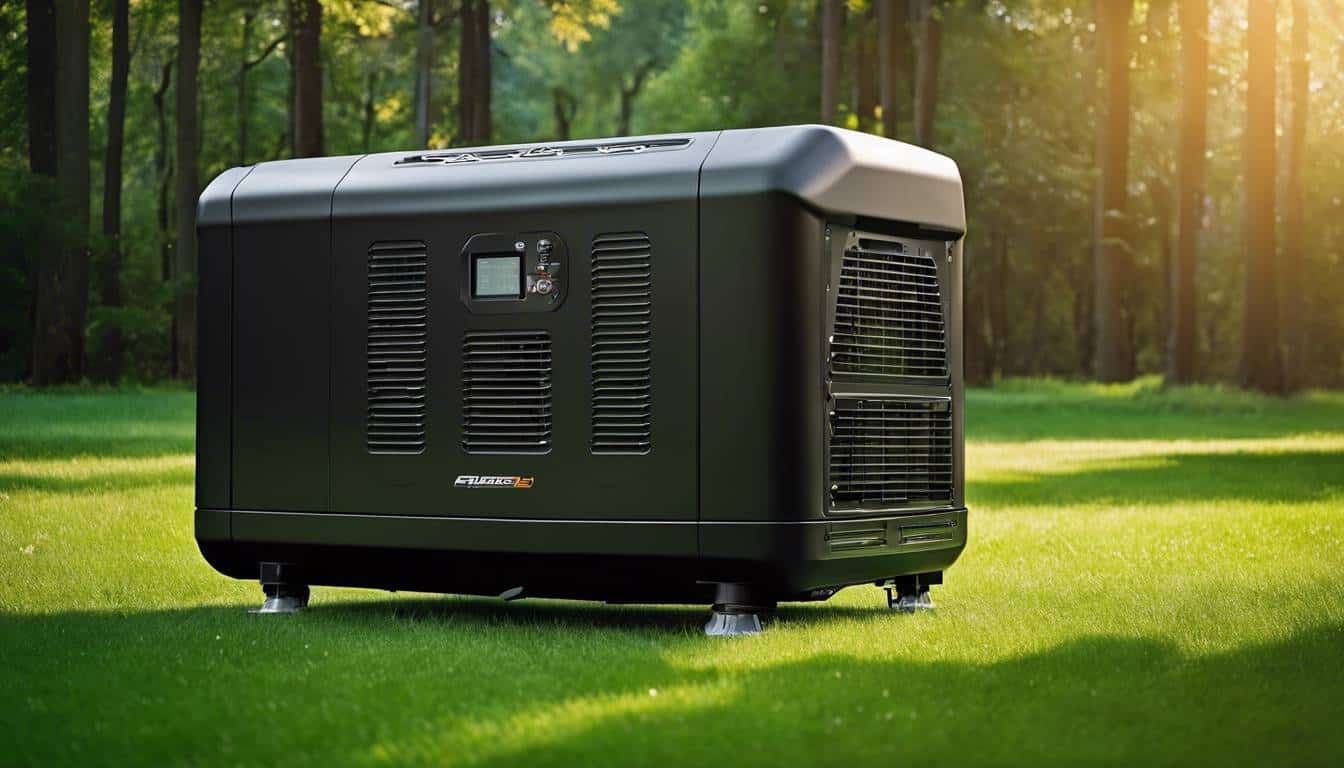In my journey to find the perfect generator for my house, I’ve learned that it all starts with understanding my home’s energy needs. It’s about identifying the essential appliances and devices that I rely on during power outages – what I like to call my blackout essentials. Identifying the right size of a generator involves assessing your specific home energy usage. This essentially means considering the vital devices and appliances that you would need to power during an outage. Known commonly as blackout essentials, these can range from refrigerators and lighting systems to heating or cooling devices and even medical equipment. In addition to this, any additional power requirements such as heavy-duty power tools in a workshop must also be considered. You’re now ready to start formulating the total required watts.
To estimate the size of a generator needed for your home, start by calculating the total wattage required for all appliances and systems that will be powered. Consider factors such as starting wattage for appliances with motors and ensure the generator can handle at least 90% of the calculated load to accommodate power surges and fluctuations. Consult with a professional electrician or use online tools to accurately size your generator based on your household’s unique power requirements.
Establishing Home Power Needs
Before delving into the technical aspects, it’s crucial to start by identifying the indispensable appliances and systems that you aim to power during a power outage. This might encompass refrigerators/freezers, lighting, heating and cooling systems, medical devices, and other critical equipment essential for your daily routine.
Calculating the total wattage required for all these appliances and systems is pivotal in determining the appropriate generator size. For example, items with motors like refrigerators or heating systems demand more power at startup than during regular operation. To account for this, you can use the formula: Running wattage (R) + Starting wattage (R x 3) = Total wattage needed.
It’s worth noting that different appliances and systems carry varying power demands. For instance, smaller devices such as light bulbs or coffee makers typically only require their running wattage. Conversely, larger units like electric furnaces or water heaters might demand significantly higher wattages both during operation and startup.
Creating a comprehensive list of all appliances and devices, along with their corresponding wattage requirements provides an overview of the total power consumption of your home during an outage scenario. For instance:
- Refrigerator: 600-800 watts
- Lights: 60-100 watts per bulb
- Television: 120-500 watts
- Microwave: 600-1200 watts
- Heating system: 1000-5000 watts
In addition to household appliances and technology, it’s important to factor in the wattages of devices such as computers, internet routers, and cell phone chargers. These everyday electronics contribute to the total power load during an outage scenario.
Lastly, estimating the duration of potential power outages in your area is important. Knowing the average duration will help determine how long your generator should sustain your essential power needs without interruption.
Establishing your home’s specific power needs is an indispensable first step in determining the most suitable generator size for your household.
In this high-stakes game of pinching pennies and strategic purchasing, being well-informed may very well be your ace in the hole. Let’s turn now to explore one such prized possession—the machine I crown champion in my digital arena.
Formulating Total Required Watts
Creating an inventory of all the appliances and devices you plan to power with your generator is crucial. Start by listing everything, from the largest items like your refrigerator and heater to the small everyday must-haves such as your coffee maker and computer. This includes capturing both their running wattage as well as their starting wattage for motor-driven appliances.
The running wattage represents the power needed to keep an appliance running, while the starting wattage is the additional power required to start appliances with a motor. For appliances with a motor, you’ll need to add both the running wattage and three times the starting wattage together to get the total wattage needed.
Calculating Total Wattage Example
Let’s take your refrigerator as an example. It may have a running wattage of 800 watts and a starting wattage of 2400 watts (800 + 2400). When you add these together, you get a total requirement of 3200 watts.
This kind of calculation will need to be carried out for every item on your list to give you an accurate impression of how much power your generator needs to deliver when all items are in use simultaneously. It’s important to remember that different devices will have different wattage requirements; some may pull large amounts of power, while others may only require minimal levels.
Diving into recommendations for managing total generator power requirements efficiently.
Understanding Appliance and Device Wattage
When considering a generator for your home, having a clear understanding of the power requirements of each appliance and device is crucial. This knowledge enables you to make an accurate assessment of the total power demand and choose a generator that can handle it effectively.
Large Appliances and Electric Motors
Large appliances like electric furnaces, air conditioners, and water heaters generally require higher wattage compared to smaller items like lights, computers, and televisions. For instance, an electric furnace can demand anywhere between 5000 and 25000 watts, while a standard television may only need 100-400 watts. Understanding these differences is essential in ensuring that your generator can adequately power all necessary devices during an outage.
Electric motors in appliances such as refrigerators, freezers, and air conditioners often require additional startup power beyond their running wattage. As a general rule, starting wattage is typically three times the running wattage for devices with motors. This distinction between running and starting wattage is crucial when sizing a generator as it ensures that you consider the additional power demands required during activation.
For example, if your refrigerator has a running wattage of 800W, the starting wattage would be 2400W (800W x 3). Taking this into account when calculating the total wattage needed helps prevent underestimating the generator capacity required to support all your appliances and devices effectively.
Some items like light bulbs and coffee makers only need to consider their running wattage as they do not have a motor that requires extra startup power. By understanding these nuances in power requirements for various appliances and devices, you can accurately assess your overall energy needs and select a generator that meets those requirements without overloading it.
Having a comprehensive understanding of the different energy needs for your household appliances and devices is critical in ensuring that your generator can provide sufficient power during an emergency. The next step involves exploring the types of generators available to determine which best suits your specific needs.
Your Essential Generator Size
Choosing the right generator size is crucial to ensure a constant power supply during outages or emergencies. It’s like finding the perfect pair of shoes – they need to fit just right. If your generator is too small, it won’t be able to handle all your needs, but if it’s too big, you’ll end up spending more than necessary.
Earlier, we calculated the total required wattage based on our appliances and devices, which gives us a clear idea of the generator capacity needed. Keep in mind, it’s recommended to choose a generator that can comfortably handle all power needs while using no more than 90 percent of its capacity. This ensures not putting excess strain on the generator and allows for any fluctuations in power demand.
Before selecting the right generator size, consider that each type has its own strengths and limitations. Let’s explore these types to understand their unique features and ideal applications.
Types of Generators
Type |
Ideal Application |
|---|---|
Portable Generators |
Versatile, affordable, and temporary power solutions |
Inverter Generators |
Quieter, fuel-efficient, suitable for camping or RV use |
Whole House Generators |
Backup power for entire homes during longer outages or frequent blackouts |
Each main type of generator is designed for specific scenarios. For versatile, affordable, and temporary power solutions during outdoor activities or emergency situations, portable generators are the go-to choice. They offer flexibility and can be used to power selected appliances as needed.
If quietness and fuel efficiency are highly valued, inverter generators are an excellent choice. These generators are suitable for charging battery-operated devices, camping or RV use, where low noise levels are crucial.
Lastly, whole house generators are designed to provide backup power for entire homes during longer outages or frequent blackouts. These systems ensure an uninterrupted power supply by automatically switching on when there is a power failure, providing peace of mind for homeowners.
Remember: Each type has its specialized application, so it’s important to align your choice with your specific needs.
With this understanding, you’ll be better equipped to select the appropriate generator size and type that best suits your individual requirements.
In the world of generators, making informed decisions can make all the difference. As we prepare to explore further insights into efficient operation methods and maintenance tips for generators, let’s dive into extra tips for maintaining optimal functionality.
Extra Tips for Generator Operation
So, you’ve got your generator set up and ready to go. Fantastic! Now, let’s talk about keeping it running like a charm.
Proper Placement
You must ensure that the generator is placed in an area that’s well-ventilated and far away from doors and windows. Why? Because this helps prevent carbon monoxide from sneaking into your home, which can be extremely dangerous. Remember, carbon monoxide is odorless, so you won’t even know it’s there until it’s too late. Play it safe and keep the area around your generator clear of obstructions, allowing plenty of air to circulate. It’s also important to be aware of your generator’s standby power consumption to ensure efficient operation.
Placing your generator on a sturdy, level surface is also key to avoiding spills and accidents. A concrete or gravel pad can serve as an ideal spot, helping prevent the generator from sinking into soft ground or getting knocked over accidentally.
Regular Maintenance
The importance of regular maintenance can’t be overstated when it comes to keeping your generator in tip-top shape. You need to make sure that your generator is always ready to kick into action when needed. This means conducting regular tests and performing basic maintenance tasks to ensure everything is running smoothly. From checking the oil level to inspecting the spark plugs, these routine checks can make all the difference during a power outage.
One important thing to remember: always have a supply of fuel on hand. It would be a terrible feeling if a power outage strikes, and you find yourself without fuel for your generator. Also, consider using fuel stabilizers if you plan to store fuel for a prolonged period. This helps keep the fuel fresh and ensures that your generator will start up without any hesitation when you need it most.
By following these simple yet crucial tips for proper placement and regular maintenance, you’ll be able to keep your generator in excellent condition and ready to provide you with power when you need it most—safety and preparedness are paramount when it comes to operating a generator effectively.
Cost Calculation: Generator and Fuel
When considering purchasing a generator, it’s essential to understand the upfront costs involved. The cost varies significantly depending on the type and size of the generator. Generally, whole-house generators are more expensive than portable ones. Factors such as brand, fuel type, and installation also affect the overall cost.
Let’s take a closer look at these different aspects:
Upfront Generator Costs
When examining the cost implications of different generator sizes and types, it’s important to consider potential installation and setup expenses. Whole-house generators come with higher upfront costs due to their capacity to power an entire home during outages. On the other hand, portable generators are relatively more affordable but may not provide backup power for all household appliances.
It’s crucial to assess your specific needs when determining the appropriate generator size. Consider the essential appliances you want to run during power outages and factor in any additional requirements such as heating or medical equipment. Evaluating these factors will help you make a more informed decision about the right generator size for your home.
Fuel Consumption
Understanding how to calculate the fuel consumption of a generator is key to managing ongoing operational costs. Fuel consumption is determined by the runtime of the generator and its fuel capacity. Longer runtimes and larger fuel capacities result in increased operational costs. It’s important to calculate and monitor fuel consumption to ensure effective management of resources.
Moreover, certain types of generators consume more fuel than others. For instance, gasoline-powered generators are generally more affordable but may have higher ongoing fuel expenses compared to natural gas or propane generators. When considering ongoing costs, it’s worth noting that some homeowners also factor in other energy-saving appliances like tankless water heaters to reduce overall energy consumption consume more fuel than others. For instance, gasoline-powered generators are generally more affordable but may have higher ongoing fuel expenses compared to natural gas or propane generators.
Comparison with Renewable Options
While generators provide immediate backup power during outages, it’s also valuable to compare their long-term costs with potential investments in renewable energy options such as solar panels or wind turbines. Renewable energy sources offer sustainable and potentially cost-effective power solutions in the long run, especially in regions where sunlight or wind resources are abundant.
For instance, while a generator requires continuous refueling and maintenance, solar panels harness energy from sunlight and convert it into electricity without ongoing fuel costs. Considering such factors can help homeowners make well-informed decisions regarding long-term energy solutions for their homes.
By carefully assessing upfront costs, potential ongoing fuel expenses, and comparison with renewable options, homeowners can make strategic decisions that align with their energy needs and long-term sustainability goals.
In a world where power outages are a reality, ensuring you have the right generator size and fuel type is vital. By making informed decisions about upfront costs, ongoing fuel expenses, and long-term energy solutions, homeowners can effectively manage their backup power needs while staying mindful of their sustainability goals.






